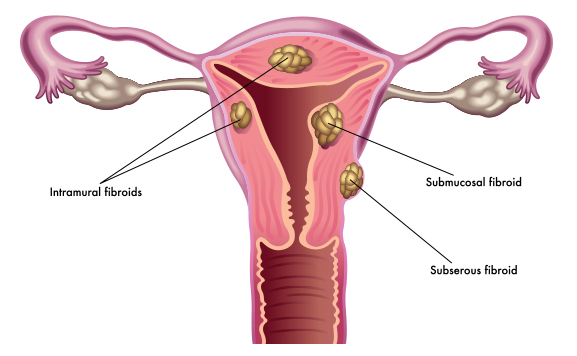Types of Fibroid Tumors – What Do Those Names Mean?
- Details
- by: Leah Johnson
Whether you’ve been diagnosed with a Uterine Fibroid, or your doctor suspects you have one, no one likes to hear that word “tumor.” Its probably why doctors usually leave that word out when discussing the presence of a fibroid tumor. But, if you’ve heard fibroid or fibroid tumor, you’re probably searching the internet for more information. Following are common questions and supportive information on fibroids, and fibroid types, as well as their related symptoms. As with any health issue, your best step is to speak to your doctor to obtain more information, but being armed with questions before that discussion can make you feel more in control of your health.
Common Questions on Fibroid Tumors:
What is a fibroid tumor?
These tumors are muscular growths within the walls of the uterus (also referred to as the womb). The different names indicate how the fibroid is positioned, and that location determines how or if you’ll have symptoms.
Are fibroids cancerous?
Fibroids are almost always benign (meaning non-cancerous). There is a very small (1 in a 1,000) chance that a fibroid tumor is cancerous. When they are, they are referred to as leiomyosarcoma. Existing non-cancerous fibroids do not become cancerous, and having fibroids does not increase your risk of cancer.
What are treatment options for fibroid tumors?
This is where your doctor is the most important resource for you. Treatment options depend on a number of factors:
- Age
- Plans for future pregnancy
- Presence or absence of symptoms
- Size of the tumor
- How near you are to menopause
Three Primary Types of Fibroid Tumors
Intramural Uterine Fibroids
The most common type of fibroid, intramural uterine fibroids are located within the uterine wall. When they grow, they can result in the uterus becoming enlarged. Doctors frequently reference their size to the stages of pregnancy (# of months). Common symptoms of this type of fibroid tumor include:
- Pain in the pelvic area
- Heavier than normal menstrual bleeding
- Lower back pain
- A sensation of pressure
Fibroids always originate in the uterine wall, but often move, or migrate to other locations, which result in the following fibroid types:
Submucosal Uterine Fibroids
Submucosal fibroids, like Intramural fibroids, are located within the lining of the uterus, but protrude inward. They can result in:
- Exceptionally heavy bleeding
- Periods lasting a long time (7+ days or more)
- Anemia (with associated exhaustion, weakness, rapid heart beat, dizziness, etc)
Subserosal Uterine Fibroids
These fibroid types are within the uterine lining, but protrude outward. They usually have less of an effect on your menstrual cycle, and may go unnoticed. But depending on location, and size, they can cause the following symptoms:
- Back pain
- Bladder pressure
Pendunculated Subserosal or Submucosal Uterine Fibroids
These fibroid tumors grow on a stalk. If you think of a stalk of broccoli, you’ll have a good idea of their appearance. The danger with this type of fibroid tumor is that the stalk, which is attached to the uterus, can twist, which cuts off blood supply to the tumor itself and can cause severe pelvic pain.
Diagnosed with fibroids? Learn more about uterine fibroid embolization. Call (800) 311-5840 today!
—————————
The U.S. Government’s Office on Women’s Health site has a great amount of information and even a handy list of questions to ask your doctor if you’ve been diagnosed with a fibroid. Getting the information on fibroids you need, to make the right health decisions for you, is important. Talk to your doctor, and understand that uterine fibroids are common, and treatable.


